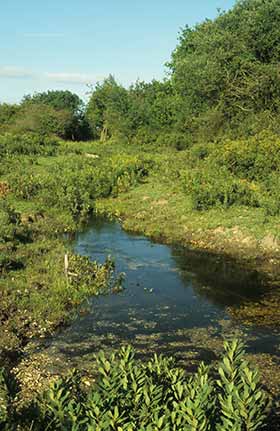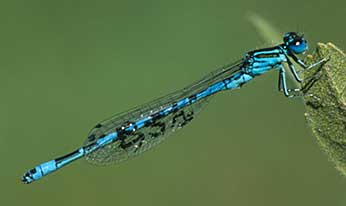Southern Damselfly (Coenagrion mercuriale)
When: Mid-May to early August
How many: Fairly abundant in preferred habitat

habitat for southern damselflies
A narrow, gravel-bottomed stream burbles off the summer heath, flowing on towards the Solent. Standing well back from the low, western bank, blackthorn thickets provide shelter from prevailing winds and rain whilst also letting plenty of sunshine reach the water’s edge. To the east, open heathland runs away into the distance. New Forest commoners’ stock – cattle, ponies and the occasional donkey – browse contentedly nearby, swishing unkempt tails to help keep away the flies.
In spring and summer, this winding ribbon of water is home to many species of dragonflies and damselflies. In April, large red damselflies are usually the first to appear. Others soon join them: broad-bodied and four-spotted chasers, common blue damselflies, southern hawkers, golden-ringed dragonflies and beautiful demoiselles, to name just a few.
But this New Forest stream is perhaps best known for its vibrant population of Southern Damselflies, tiny, needle-thin insects with a body length of not much more than 2.5 centimetres (1 inch), and a wingspan only marginally greater. Southern Damselfly males are predominantly bright blue and black, with an identifying black ‘mercury’ mark on the second segment of the abdomen, the long, thin, ‘tail’ attached to the body, or thorax as it is more properly known. Females are generally much darker above. Confusingly, some females have a green ground colour, others have blue.
Southern Damselfly flight is weak and stuttering, and usually at fairly low level. Prolonged periods are spent at rest – perched in the sunlight, or in dull weather, down amongst the herbage.
Strong, stable populations of these beautiful insects prosper in the New Forest, which is close to the northern edge of their world range. Unfortunately, however, Southern Damselflies are rare elsewhere in much of Britain, and have suffered a 30% decline in distribution during the last 100 years. Globally, they are also threatened – the UK supports 25% of the world’s population.

Protected under the Wildlife and Countryside Act, 1981, Southern Damselflies are also the only British resident dragonfly or damselfly listed in the European Habitats Directive, they are specifically mentioned in the Berne Convention, and are also counted as ‘rare’ in the GB Red Data Book. Not surprisingly, Southern Damselflies also get special attention in the UK Biodiversity Action Plan, which sets conservation targets and intended protection measures for particularly sensitive species.
Fragile creatures in more ways than one, Southern Damselflies are very choosy about where they live, which to a large extent, explains both their scarcity and their vulnerability. Research indicates a preference for shallow, reasonably well-vegetated, slow moving, narrow, unpolluted streams with base-rich water running over a slightly acid substrate. Southern Damselflies also like low banks to be present, with short bank-side vegetation and plenty of sunlight.
In fact, streams such as this, and others in the New Forest, are essential for this beautiful insect’s survival.
References:
A Guide to the Dragonflies of Great Britain: Dan Powell
Dragonflies and Damselflies of Britain and Northern Europe: Bob Gibbons
More links
Other related links
Search this site

Sadly, 58 animals were killed - 35 ponies, 13 cows, 8 donkeys and 2 sheep, whilst a further 32 were injured - 3 pigs, 9 donkeys, 11 cows and 9 ponies.
(Forty-three accidents occurred in daylight, 15 at twilight and 101 in the dark. Twenty-seven accidents were not reported by the driver involved).
Here's just one horrific example - Three donkeys killed in collision with van at notorious New Forest blackspot (Advertiser and Times)

